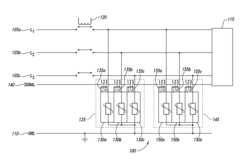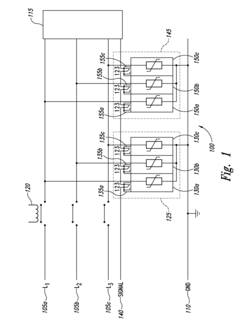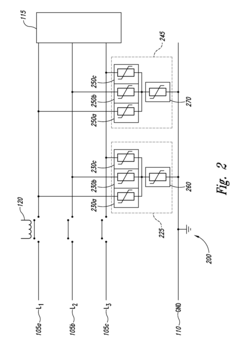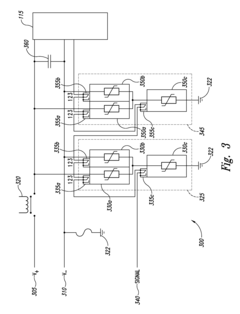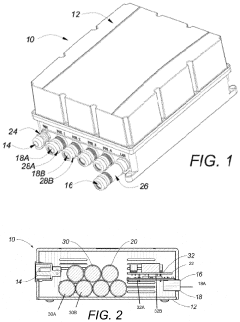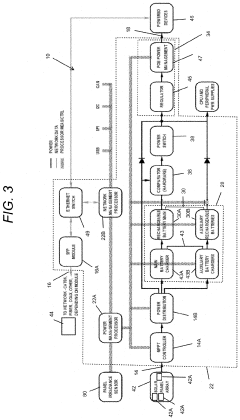Solar Inverters vs. Traditional Power Systems: A Comparison
JUL 17, 20259 MIN READ
Generate Your Research Report Instantly with AI Agent
Patsnap Eureka helps you evaluate technical feasibility & market potential.
Solar Inverter Evolution and Objectives
Solar inverter technology has undergone significant evolution since its inception in the 1990s. Initially designed to convert DC power from solar panels into AC power for grid use, these devices have transformed from simple converters to sophisticated power management systems. The primary objective of solar inverters has consistently been to maximize energy harvest from photovoltaic arrays while ensuring grid compatibility and system reliability.
Early solar inverters were centralized units, handling power from multiple solar panels. As the technology progressed, string inverters emerged, offering improved efficiency and flexibility. The introduction of microinverters in the mid-2000s marked a paradigm shift, enabling panel-level power conversion and monitoring. This evolution has been driven by the need for higher efficiency, enhanced safety, and improved grid integration capabilities.
The objectives of modern solar inverters extend beyond mere power conversion. They aim to optimize energy yield through advanced Maximum Power Point Tracking (MPPT) algorithms, which dynamically adjust to changing environmental conditions. Grid support features have become increasingly important, with inverters now capable of providing reactive power, voltage regulation, and frequency response to stabilize the grid.
Reliability and longevity have emerged as critical objectives in solar inverter development. Manufacturers are focusing on robust designs that can withstand harsh environmental conditions and operate efficiently for 20 years or more. This includes advancements in thermal management, component selection, and protective features to ensure long-term performance and reduce maintenance requirements.
Another key objective is the integration of energy storage systems. Hybrid inverters, capable of managing both solar input and battery storage, are gaining prominence. These systems aim to increase energy self-consumption, provide backup power during outages, and enable participation in grid services, enhancing the overall value proposition of solar installations.
Smart functionality and connectivity have become integral to solar inverter design. Modern inverters incorporate advanced monitoring and communication capabilities, allowing for remote diagnostics, performance optimization, and seamless integration with home energy management systems. This aligns with the broader trend towards smart grids and the Internet of Things (IoT) in the energy sector.
As the solar industry continues to grow, inverter technology is evolving to meet new challenges. Future objectives include further improvements in power density, efficiency, and cost-effectiveness. There is also a focus on developing inverters that can handle higher DC voltages, accommodate bifacial solar panels, and integrate seamlessly with emerging technologies such as electric vehicle charging infrastructure.
Early solar inverters were centralized units, handling power from multiple solar panels. As the technology progressed, string inverters emerged, offering improved efficiency and flexibility. The introduction of microinverters in the mid-2000s marked a paradigm shift, enabling panel-level power conversion and monitoring. This evolution has been driven by the need for higher efficiency, enhanced safety, and improved grid integration capabilities.
The objectives of modern solar inverters extend beyond mere power conversion. They aim to optimize energy yield through advanced Maximum Power Point Tracking (MPPT) algorithms, which dynamically adjust to changing environmental conditions. Grid support features have become increasingly important, with inverters now capable of providing reactive power, voltage regulation, and frequency response to stabilize the grid.
Reliability and longevity have emerged as critical objectives in solar inverter development. Manufacturers are focusing on robust designs that can withstand harsh environmental conditions and operate efficiently for 20 years or more. This includes advancements in thermal management, component selection, and protective features to ensure long-term performance and reduce maintenance requirements.
Another key objective is the integration of energy storage systems. Hybrid inverters, capable of managing both solar input and battery storage, are gaining prominence. These systems aim to increase energy self-consumption, provide backup power during outages, and enable participation in grid services, enhancing the overall value proposition of solar installations.
Smart functionality and connectivity have become integral to solar inverter design. Modern inverters incorporate advanced monitoring and communication capabilities, allowing for remote diagnostics, performance optimization, and seamless integration with home energy management systems. This aligns with the broader trend towards smart grids and the Internet of Things (IoT) in the energy sector.
As the solar industry continues to grow, inverter technology is evolving to meet new challenges. Future objectives include further improvements in power density, efficiency, and cost-effectiveness. There is also a focus on developing inverters that can handle higher DC voltages, accommodate bifacial solar panels, and integrate seamlessly with emerging technologies such as electric vehicle charging infrastructure.
Market Demand Analysis for Solar Inverters
The global market for solar inverters has been experiencing significant growth, driven by the increasing adoption of solar energy systems worldwide. This surge in demand is primarily fueled by the growing awareness of environmental issues, government incentives for renewable energy adoption, and the declining costs of solar technology.
In recent years, the solar inverter market has witnessed a compound annual growth rate (CAGR) of over 15%, with projections indicating continued strong growth in the coming years. This growth is particularly pronounced in regions with high solar potential and supportive government policies, such as China, the United States, and several European countries.
The residential sector has emerged as a key driver of solar inverter demand, as homeowners increasingly seek to reduce their electricity bills and carbon footprint. The commercial and industrial sectors are also contributing significantly to market growth, with businesses recognizing the long-term cost savings and sustainability benefits of solar energy systems.
Technological advancements in solar inverter design have further stimulated market demand. Modern inverters offer improved efficiency, reliability, and smart features such as remote monitoring and grid integration capabilities. These innovations have made solar energy systems more attractive to a broader range of consumers and have opened up new application possibilities.
The increasing focus on energy storage solutions has also boosted the demand for hybrid inverters, which can manage both solar power generation and battery storage. This trend is expected to continue as more consumers seek to maximize their energy independence and resilience against grid outages.
Geographically, Asia-Pacific leads the solar inverter market, with China being the largest contributor. Europe and North America follow closely, with emerging markets in Latin America, Africa, and the Middle East showing promising growth potential. The market landscape is characterized by a mix of established global players and regional manufacturers, fostering innovation and competitive pricing.
Despite the positive outlook, challenges such as grid integration issues, regulatory uncertainties, and supply chain disruptions pose potential obstacles to market growth. However, ongoing research and development efforts, coupled with supportive government policies, are expected to address these challenges and further drive the adoption of solar inverters in both grid-tied and off-grid applications.
In recent years, the solar inverter market has witnessed a compound annual growth rate (CAGR) of over 15%, with projections indicating continued strong growth in the coming years. This growth is particularly pronounced in regions with high solar potential and supportive government policies, such as China, the United States, and several European countries.
The residential sector has emerged as a key driver of solar inverter demand, as homeowners increasingly seek to reduce their electricity bills and carbon footprint. The commercial and industrial sectors are also contributing significantly to market growth, with businesses recognizing the long-term cost savings and sustainability benefits of solar energy systems.
Technological advancements in solar inverter design have further stimulated market demand. Modern inverters offer improved efficiency, reliability, and smart features such as remote monitoring and grid integration capabilities. These innovations have made solar energy systems more attractive to a broader range of consumers and have opened up new application possibilities.
The increasing focus on energy storage solutions has also boosted the demand for hybrid inverters, which can manage both solar power generation and battery storage. This trend is expected to continue as more consumers seek to maximize their energy independence and resilience against grid outages.
Geographically, Asia-Pacific leads the solar inverter market, with China being the largest contributor. Europe and North America follow closely, with emerging markets in Latin America, Africa, and the Middle East showing promising growth potential. The market landscape is characterized by a mix of established global players and regional manufacturers, fostering innovation and competitive pricing.
Despite the positive outlook, challenges such as grid integration issues, regulatory uncertainties, and supply chain disruptions pose potential obstacles to market growth. However, ongoing research and development efforts, coupled with supportive government policies, are expected to address these challenges and further drive the adoption of solar inverters in both grid-tied and off-grid applications.
Solar vs Traditional Power: Current State
Solar power systems and traditional power systems represent two distinct approaches to electricity generation and distribution. Currently, solar power systems are gaining significant traction due to their renewable nature and decreasing costs, while traditional power systems continue to dominate the global energy landscape.
Traditional power systems, primarily based on fossil fuels such as coal, natural gas, and oil, have been the backbone of electricity generation for over a century. These systems typically involve large centralized power plants that generate electricity through the combustion of fossil fuels or nuclear fission. The electricity is then transmitted over long distances through high-voltage power lines and distributed to end-users via local grids.
In contrast, solar power systems harness energy from the sun using photovoltaic (PV) panels or concentrated solar power (CSP) technologies. Solar inverters play a crucial role in these systems by converting the direct current (DC) generated by solar panels into alternating current (AC) suitable for use in homes, businesses, and the power grid.
One of the key advantages of traditional power systems is their ability to provide consistent, baseload power regardless of weather conditions or time of day. They also benefit from well-established infrastructure and decades of operational experience. However, these systems face increasing scrutiny due to their environmental impact, particularly greenhouse gas emissions and air pollution.
Solar power systems, on the other hand, offer several advantages over traditional systems. They produce clean, renewable energy with minimal operational emissions and have significantly lower environmental impacts. Solar systems also provide energy independence and can be deployed in both centralized and distributed configurations, allowing for greater flexibility in power generation.
However, solar power systems face challenges related to intermittency and energy storage. Solar panels only generate electricity during daylight hours and are affected by weather conditions, requiring energy storage solutions or grid integration to ensure reliable power supply. Additionally, the initial costs of solar installations can be higher than traditional systems, although these costs have been decreasing rapidly in recent years.
In terms of efficiency, traditional power systems typically have higher conversion efficiencies than solar PV systems. However, solar technology continues to improve, with new materials and designs pushing the boundaries of solar cell efficiency. Moreover, when considering the entire lifecycle and environmental costs, solar systems often outperform traditional power systems in terms of overall efficiency and sustainability.
The current state of power generation is characterized by a gradual shift towards renewable sources, with solar power playing an increasingly important role. Many countries are implementing policies and incentives to promote solar adoption, leading to rapid growth in solar installations worldwide. However, traditional power systems remain dominant in most regions due to their established infrastructure and the challenges associated with large-scale integration of intermittent renewable sources.
Traditional power systems, primarily based on fossil fuels such as coal, natural gas, and oil, have been the backbone of electricity generation for over a century. These systems typically involve large centralized power plants that generate electricity through the combustion of fossil fuels or nuclear fission. The electricity is then transmitted over long distances through high-voltage power lines and distributed to end-users via local grids.
In contrast, solar power systems harness energy from the sun using photovoltaic (PV) panels or concentrated solar power (CSP) technologies. Solar inverters play a crucial role in these systems by converting the direct current (DC) generated by solar panels into alternating current (AC) suitable for use in homes, businesses, and the power grid.
One of the key advantages of traditional power systems is their ability to provide consistent, baseload power regardless of weather conditions or time of day. They also benefit from well-established infrastructure and decades of operational experience. However, these systems face increasing scrutiny due to their environmental impact, particularly greenhouse gas emissions and air pollution.
Solar power systems, on the other hand, offer several advantages over traditional systems. They produce clean, renewable energy with minimal operational emissions and have significantly lower environmental impacts. Solar systems also provide energy independence and can be deployed in both centralized and distributed configurations, allowing for greater flexibility in power generation.
However, solar power systems face challenges related to intermittency and energy storage. Solar panels only generate electricity during daylight hours and are affected by weather conditions, requiring energy storage solutions or grid integration to ensure reliable power supply. Additionally, the initial costs of solar installations can be higher than traditional systems, although these costs have been decreasing rapidly in recent years.
In terms of efficiency, traditional power systems typically have higher conversion efficiencies than solar PV systems. However, solar technology continues to improve, with new materials and designs pushing the boundaries of solar cell efficiency. Moreover, when considering the entire lifecycle and environmental costs, solar systems often outperform traditional power systems in terms of overall efficiency and sustainability.
The current state of power generation is characterized by a gradual shift towards renewable sources, with solar power playing an increasingly important role. Many countries are implementing policies and incentives to promote solar adoption, leading to rapid growth in solar installations worldwide. However, traditional power systems remain dominant in most regions due to their established infrastructure and the challenges associated with large-scale integration of intermittent renewable sources.
Existing Solar Inverter Solutions
01 Integration of solar inverters with traditional power systems
Solar inverters are designed to seamlessly integrate with traditional power systems, allowing for efficient conversion of DC power from solar panels to AC power compatible with the grid. This integration enables bidirectional power flow, grid support functions, and improved overall system reliability.- Integration of solar inverters with traditional power systems: Solar inverters are designed to seamlessly integrate with traditional power systems, allowing for efficient conversion of DC power from solar panels to AC power compatible with the grid. This integration enables bidirectional power flow, grid support functions, and improved overall system reliability.
- Power management and control strategies: Advanced control algorithms and power management strategies are implemented in solar inverters to optimize energy production, regulate voltage and frequency, and ensure stable operation when connected to traditional power systems. These strategies include maximum power point tracking, reactive power control, and fault ride-through capabilities.
- Grid support and ancillary services: Solar inverters are equipped with features that enable them to provide grid support and ancillary services to traditional power systems. These services include voltage regulation, frequency response, and power factor correction, which help maintain grid stability and power quality.
- Energy storage integration: Solar inverters are increasingly designed to integrate with energy storage systems, allowing for better management of intermittent solar power generation and improved grid stability. This integration enables features such as peak shaving, load shifting, and backup power capabilities.
- Smart grid compatibility and communication protocols: Modern solar inverters incorporate communication protocols and smart grid functionalities to enable seamless interaction with traditional power systems. These features allow for remote monitoring, control, and optimization of solar power generation, as well as improved coordination with utility operations.
02 Power management and control strategies
Advanced power management and control strategies are implemented in solar inverter systems to optimize energy production, distribution, and consumption. These strategies include maximum power point tracking, reactive power control, and intelligent load management to enhance system efficiency and grid stability.Expand Specific Solutions03 Grid support and stability features
Modern solar inverters incorporate grid support features to enhance the stability and reliability of traditional power systems. These features include voltage and frequency regulation, fault ride-through capabilities, and active power curtailment to maintain grid stability during fluctuations in solar power generation.Expand Specific Solutions04 Energy storage integration
Solar inverter systems are increasingly integrating energy storage solutions to address the intermittent nature of solar power generation. This integration allows for better load balancing, peak shaving, and improved overall system reliability by storing excess energy for use during periods of low solar production or high demand.Expand Specific Solutions05 Smart grid compatibility and communication protocols
Solar inverters are designed with smart grid compatibility and advanced communication protocols to facilitate seamless integration with traditional power systems. These features enable real-time monitoring, remote control, and data exchange between solar inverters and grid operators, enhancing overall system performance and grid management.Expand Specific Solutions
Key Players in Solar Inverter Industry
The solar inverter market is in a mature growth phase, with a global market size expected to reach $27 billion by 2026. The technology has evolved significantly, moving from traditional centralized inverters to more advanced string and microinverters. Key players like SolarEdge Technologies, Enphase Energy, and SMA Solar Technology are driving innovation in smart, efficient inverter solutions. Established electronics giants such as Huawei, Delta Electronics, and Mitsubishi Electric are also competing in this space, leveraging their expertise in power electronics. The market is characterized by intense competition and rapid technological advancements, with a focus on improving efficiency, reliability, and grid integration capabilities.
SolarEdge Technologies, Inc.
Technical Solution: SolarEdge Technologies has pioneered the concept of DC-optimized inverter systems for solar power. Their solution combines power optimizers at the module level with a central inverter. This approach allows for Maximum Power Point Tracking (MPPT) for each individual solar panel, maximizing energy production even in cases of partial shading or module mismatch[1]. SolarEdge's HD-Wave technology uses distributed switching and advanced digital processing to synthesize a clean sine wave, resulting in inverters that are smaller, lighter, and more efficient than traditional inverters[2]. The company has also integrated advanced monitoring and safety features, such as rapid shutdown capabilities and arc fault detection, enhancing overall system performance and safety[3].
Strengths: Optimized power harvesting, high efficiency, advanced monitoring capabilities. Weaknesses: Higher upfront costs, system complexity may increase installation time.
Enphase Energy, Inc.
Technical Solution: Enphase Energy specializes in microinverter technology for solar power systems. Their microinverters convert DC to AC at the individual panel level, offering several advantages over traditional string inverters. Enphase's IQ8 microinverters feature "grid-forming" technology, allowing them to operate in both grid-tied and off-grid modes, providing power even during grid outages without the need for batteries[1]. The company's Ensemble energy management system integrates microinverters with battery storage and smart load control, enabling comprehensive energy management and optimization[2]. Enphase also offers advanced monitoring through their Enlighten software platform, providing detailed performance data and remote troubleshooting capabilities[3].
Strengths: Panel-level power conversion, enhanced system reliability, advanced energy management capabilities. Weaknesses: Higher per-watt cost compared to string inverters, more components to potentially fail.
Core Innovations in Solar Inverter Technology
Solar power inverters, including solar power inverters having surge protective devices, and associated methods
PatentInactiveUS8390977B2
Innovation
- Implementing multiple SPDs electrically coupled in parallel, with different clamping voltages, where the first SPD acts before the second SPD, providing redundant protection and reducing the likelihood of both failing simultaneously, thus offering enhanced protection against voltage surges.
System and method for supplying uninterruptible power to a PoE device with a power supply input for solar power
PatentActiveUS11456616B2
Innovation
- A system with a housing connected to a solar panel power supply input, an alternative power supply, and a control module that manages power distribution and battery charging, using a panel irradiance sensor to optimize solar energy usage and ensure uninterrupted power to PoE devices, even in remote locations.
Grid Integration Challenges and Solutions
The integration of solar inverters into traditional power systems presents significant challenges and opportunities for grid operators and utilities. One of the primary challenges is the intermittent nature of solar power generation, which can lead to voltage fluctuations and power quality issues. To address this, advanced grid management systems are being developed to predict and respond to changes in solar output more effectively.
Smart inverters play a crucial role in mitigating these challenges. These devices can provide reactive power support, voltage regulation, and frequency response capabilities, helping to maintain grid stability. Additionally, they can communicate with grid operators in real-time, allowing for more precise control and coordination of distributed energy resources.
Energy storage systems are increasingly being integrated alongside solar inverters to smooth out power fluctuations and provide grid services. Battery storage can store excess solar energy during peak production hours and release it during periods of high demand or low solar output. This not only improves grid stability but also enhances the overall value proposition of solar installations.
Grid operators are also implementing advanced forecasting tools and algorithms to better predict solar power generation. These systems use weather data, historical performance, and machine learning techniques to provide more accurate short-term and long-term forecasts, enabling better grid management and resource allocation.
The development of microgrids and virtual power plants (VPPs) is another solution to integration challenges. These systems aggregate multiple distributed energy resources, including solar inverters, and coordinate their operation to provide grid services and enhance overall system reliability. VPPs can help balance supply and demand at a local level, reducing strain on the broader grid infrastructure.
Standardization and interoperability are critical factors in addressing integration challenges. Efforts are underway to develop common communication protocols and standards for solar inverters and other grid-connected devices. This will facilitate seamless integration and enable more efficient coordination between different components of the power system.
As the penetration of solar power continues to increase, grid operators are also exploring new market mechanisms and tariff structures to incentivize the provision of grid services from solar inverters and associated systems. These may include capacity payments, ancillary service markets, and time-of-use pricing schemes that encourage optimal use of solar resources.
Smart inverters play a crucial role in mitigating these challenges. These devices can provide reactive power support, voltage regulation, and frequency response capabilities, helping to maintain grid stability. Additionally, they can communicate with grid operators in real-time, allowing for more precise control and coordination of distributed energy resources.
Energy storage systems are increasingly being integrated alongside solar inverters to smooth out power fluctuations and provide grid services. Battery storage can store excess solar energy during peak production hours and release it during periods of high demand or low solar output. This not only improves grid stability but also enhances the overall value proposition of solar installations.
Grid operators are also implementing advanced forecasting tools and algorithms to better predict solar power generation. These systems use weather data, historical performance, and machine learning techniques to provide more accurate short-term and long-term forecasts, enabling better grid management and resource allocation.
The development of microgrids and virtual power plants (VPPs) is another solution to integration challenges. These systems aggregate multiple distributed energy resources, including solar inverters, and coordinate their operation to provide grid services and enhance overall system reliability. VPPs can help balance supply and demand at a local level, reducing strain on the broader grid infrastructure.
Standardization and interoperability are critical factors in addressing integration challenges. Efforts are underway to develop common communication protocols and standards for solar inverters and other grid-connected devices. This will facilitate seamless integration and enable more efficient coordination between different components of the power system.
As the penetration of solar power continues to increase, grid operators are also exploring new market mechanisms and tariff structures to incentivize the provision of grid services from solar inverters and associated systems. These may include capacity payments, ancillary service markets, and time-of-use pricing schemes that encourage optimal use of solar resources.
Environmental Impact Assessment
The environmental impact assessment of solar inverters compared to traditional power systems reveals significant differences in their ecological footprints. Solar inverters, as key components of photovoltaic systems, contribute to a substantial reduction in greenhouse gas emissions over their lifecycle. When compared to traditional power systems, which often rely on fossil fuels, solar inverters facilitate a cleaner energy production process with minimal direct emissions during operation.
The manufacturing phase of solar inverters does involve some environmental costs, primarily related to the extraction and processing of raw materials such as silicon, copper, and various rare earth elements. However, these impacts are generally offset by the long-term environmental benefits of clean energy production. In contrast, traditional power systems continue to generate emissions throughout their operational life, contributing to air pollution and climate change.
Water consumption is another critical factor in this assessment. Solar inverter systems typically require minimal water for operation, mainly for occasional cleaning of solar panels. Traditional power plants, especially those using steam turbines, consume vast quantities of water for cooling purposes, potentially straining local water resources. This difference becomes particularly significant in water-scarce regions.
Land use considerations also favor solar inverter systems. While large-scale solar farms do require substantial land area, they can often be integrated into existing structures or marginal lands. Traditional power plants, along with their fuel extraction and processing facilities, generally have a more intensive and less flexible land use profile.
The end-of-life phase presents both challenges and opportunities. Solar inverters and associated components can be recycled, recovering valuable materials and reducing waste. However, the recycling infrastructure for these technologies is still developing. Traditional power systems often leave behind contaminated sites requiring extensive remediation.
Noise pollution is another aspect where solar inverters demonstrate an advantage. They operate quietly, causing minimal disturbance to surrounding ecosystems and communities. In contrast, many traditional power plants generate significant noise, potentially affecting local wildlife and human populations.
Biodiversity impacts also differ significantly. Solar installations, when properly planned, can coexist with local flora and fauna. Some studies even suggest that solar farms can enhance biodiversity by providing habitats for certain species. Traditional power systems, particularly those involving fossil fuel extraction, often lead to more severe habitat disruption and biodiversity loss.
The manufacturing phase of solar inverters does involve some environmental costs, primarily related to the extraction and processing of raw materials such as silicon, copper, and various rare earth elements. However, these impacts are generally offset by the long-term environmental benefits of clean energy production. In contrast, traditional power systems continue to generate emissions throughout their operational life, contributing to air pollution and climate change.
Water consumption is another critical factor in this assessment. Solar inverter systems typically require minimal water for operation, mainly for occasional cleaning of solar panels. Traditional power plants, especially those using steam turbines, consume vast quantities of water for cooling purposes, potentially straining local water resources. This difference becomes particularly significant in water-scarce regions.
Land use considerations also favor solar inverter systems. While large-scale solar farms do require substantial land area, they can often be integrated into existing structures or marginal lands. Traditional power plants, along with their fuel extraction and processing facilities, generally have a more intensive and less flexible land use profile.
The end-of-life phase presents both challenges and opportunities. Solar inverters and associated components can be recycled, recovering valuable materials and reducing waste. However, the recycling infrastructure for these technologies is still developing. Traditional power systems often leave behind contaminated sites requiring extensive remediation.
Noise pollution is another aspect where solar inverters demonstrate an advantage. They operate quietly, causing minimal disturbance to surrounding ecosystems and communities. In contrast, many traditional power plants generate significant noise, potentially affecting local wildlife and human populations.
Biodiversity impacts also differ significantly. Solar installations, when properly planned, can coexist with local flora and fauna. Some studies even suggest that solar farms can enhance biodiversity by providing habitats for certain species. Traditional power systems, particularly those involving fossil fuel extraction, often lead to more severe habitat disruption and biodiversity loss.
Unlock deeper insights with Patsnap Eureka Quick Research — get a full tech report to explore trends and direct your research. Try now!
Generate Your Research Report Instantly with AI Agent
Supercharge your innovation with Patsnap Eureka AI Agent Platform!
